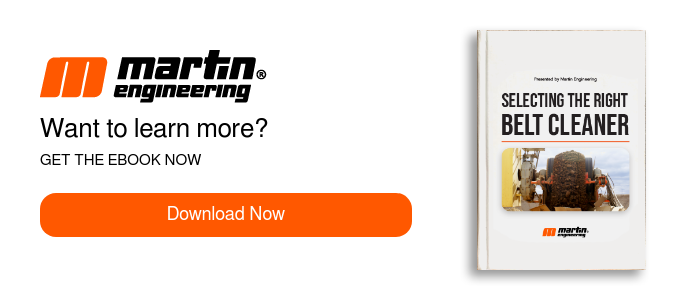Why To Add A Secondary Belt Cleaner To Your Operation
Refining Secondary Belt Cleaning for Improved Performance
 |
| Secondary cleaners are defined as any cleaner located in the area from just before the point where the belt leaves contact with the head pulley to just before the belt contacts the snub pulley. |
While primary cleaners handle initial rough cleaning, secondary cleaners focus on fine cleaning materials that have passed by the primary cleaner. Achieving desired cleanliness levels may necessitate multiple secondary cleaners. The proximity of these cleaners to the conveyor’s discharge point reduces risks associated with fines buildup in the dribble chute.
Multiple belt cleaner systems take into consideration the dynamics of the surface of the belt and the nature of the material as it passes around the head pulley.
Ideally, secondary cleaners should contact the belt 50 to 100 millimeters (2 to 4 inches) past the head pulley departure point to effectively scrape against a solid surface for optimal material removal.
 |
| Cleaning performance will be less effective if a secondary cleaner is installed in a position where its pressure changes the belt's line of travel. |
Constraints such as conveyor structure, space limitations, or mechanical splices may require secondary cleaners to be positioned where material falls into the chute. Installing a secondary cleaner in a manner that alters the belt’s travel line diminishes its cleaning effectiveness. To mitigate this, hold-down rolls or similar devices should be employed to stabilize the belt line.
 |
| The best location for a secondary cleaner is to place it in contact with the belt while the belt is still against the head pulley, allowing it to scrape against a firm surface. |
The blade angle of attack against the belt is critical. Metal- or ceramic-tipped blades in a positive rake position can become excessively sharp due to belt movement, risking damage if improperly adjusted. To counteract this, blades should be angled in the direction of belt travel (negative rake) when dealing with obstructions or mechanical splices. Research suggests an optimal angle of 7 to 15 degrees in the direction of belt travel maintains cleaning efficiency while facilitating obstruction passage.
 |
| An angle of 7 to 15 degrees rake in the direction of belt travel maintains cleaning efficiency while allowing easier passage of obstructions. |
Secondary cleaners benefit from narrow, independently suspended blades that maintain precise contact with the belt’s changing surface contours. Blades that pivot or rock from side to side adapt instantly to these contours. Studies recommend using individual blades, each 75 to 200 millimeters (3 to 8 inches) wide, for effective secondary cleaning.
 |
| To avoid “stripes” of carryback created by gaps between the blades, an overlapping blade pattern, created by an alternating long-arm/short-arm pattern, can be used. |
The Bureau of Mines’ study, Basic Parameters of Conveyor Belt Cleaning, identifies initial blade wear occurring where individual blades meet. Material passing through gaps between adjacent blades accelerates wear and allows more carryback. To mitigate this erosive wear, overlapping blade patterns such as alternating long-arm/short-arm configurations or offsetting gaps in two aligned cleaners are recommended.
